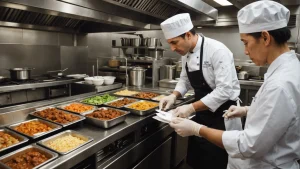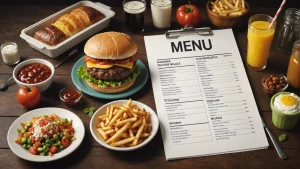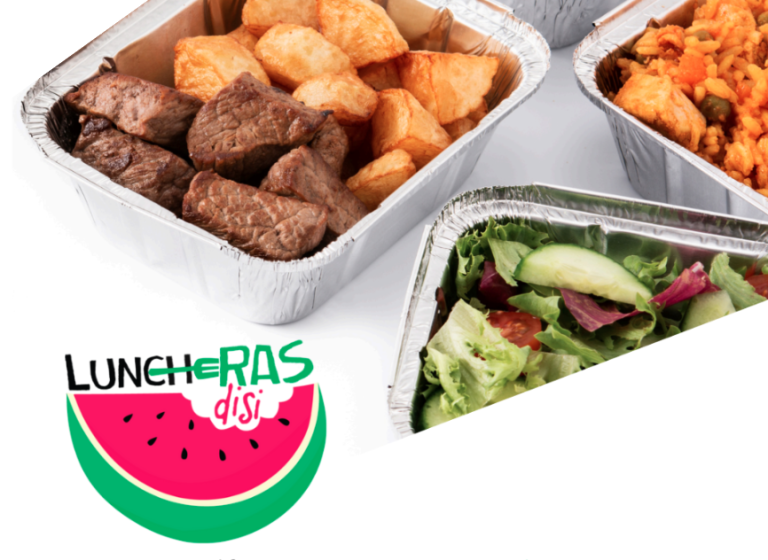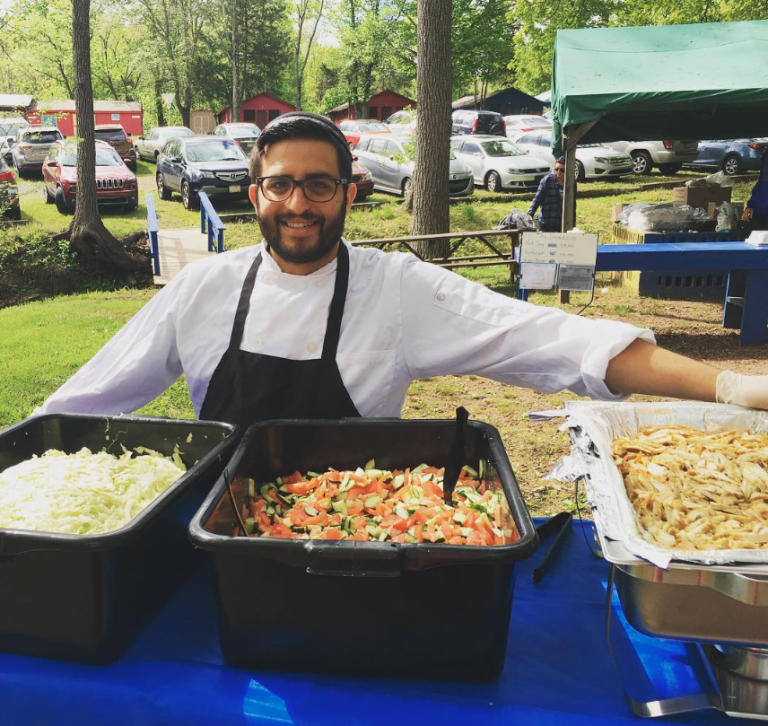In 2024, food safety compliance is more crucial than ever for restaurants. With evolving regulations and heightened customer expectations, ensuring the safety of your patrons is not just a legal obligation but a fundamental responsibility.
This comprehensive guide breaks down the essential restaurant food safety guidelines, providing you with a clear roadmap to navigate the complexities of compliance in 2024. From proper food storage and temperature control to thorough cooking procedures and strict personal hygiene practices, we cover the critical aspects you need to master.
By implementing these guidelines of food safety basics and best practices, you’ll not only protect your customers and reputation but also foster a culture of food safety excellence in your establishment.

Lower your delivery costs by 23%
How we reduce costs:
- No delivery vehicle expenses
- Optimized local routes
- Pay-per-delivery model
- Average 23% delivery cost reduction
Master the Top 5 Restaurant Food Safety Guidelines for 2024 Compliance
Proper Food Storage and Temperature Control
Proper food storage and temperature control are essential for preventing bacterial growth and ensuring the safety of your restaurant’s dishes. Begin by ensuring that all foods are stored at the appropriate temperatures. Refrigerated items should be kept at 40°F (4°C) or below, while frozen foods must be maintained at 0°F (-18°C) or lower. Use clearly labeled containers to store food, and follow the FIFO (First In, First Out) inventory management system to ensure that older items are used before newer ones. This helps minimize waste and reduces the risk of spoilage.
Regularly monitor and record the temperatures of your refrigerators and freezers using accurate thermometers. Assign a staff member to check appliance thermometer and log temperatures at least twice a day, preferably at the beginning and end of each shift. If temperatures fall outside the safe range, take immediate corrective action, such as adjusting the thermostat or relocating food to a properly functioning unit.
Food Thermometer Usage:
Only 62% of consumers own a food thermometer, and usage varies depending on the type of food being cooked, with lower usage rates for chicken parts, burgers, egg dishes, and frozen meals
Dry Food Storage Best Practices
In addition to using cold water for storage, it’s crucial to maintain proper conditions for dry food storage. Keep dry goods in a clean, dry, and well-ventilated area, away from direct sunlight and heat sources. Store food at least 6 inches (15 cm) off the floor and away from walls to allow for adequate air circulation and to prevent pest infestations. Use airtight containers to protect dry goods from moisture and contamination, and label them with the contents and expiration dates.
Thorough Cooking and Reheating Procedures
Cooking foods to their recommended internal temperatures is crucial for killing harmful bacteria and preventing foodborne illnesses. Use a food thermometer to ensure that dishes reach the appropriate temperature before serving. For example, ground beef should be cooked to at least 160°F (71°C), while poultry must reach a minimum internal temperature of 165°F (74°C).
When reheating leftovers, it’s essential to bring the food to a temperature of at least 165°F (74°C) to ensure that any bacteria that may have grown on cooked foods during storage are eliminated. Reheat foods quickly, and avoid using slow cooking methods like warming trays or steam tables, as these can allow bacteria to thrive in the “danger zone” between 40°F (4°C) and 140°F (60°C).
Strict Personal Hygiene Practices for Staff
Maintaining strict personal hygiene practices among your staff is vital for preventing the spread of foodborne illnesses. Enforce proper handwashing techniques and frequency, requiring employees to wash their hands with soap and warm water for at least 20 seconds before handling food, after using the restroom, and after touching any potentially contaminated surfaces.
Ensure that all staff members, including chefs, wear clean uniforms, hair restraints, and gloves when handling food. Regularly inspect and replace gloves to avoid cross-contamination. Prohibit staff from working when they are ill, especially if they have symptoms such as vomiting, diarrhea, or a fever. Implement a clear sick leave policy and train employees on the importance of reporting illnesses to management.
Hand Washing:
Restaurant workers are more likely to wash their hands with soap after touching raw meat, poultry, or seafood than after touching raw vegetables or fruit
Regular Cleaning and Sanitizing of Equipment and Surfaces
Establish and follow a comprehensive cleaning schedule for all kitchen equipment and surfaces to minimize the risk of cross-contamination. Use approved sanitizers and disinfectants, following the manufacturer’s instructions for dilution and contact time. Train staff on proper cleaning and sanitizing procedures, emphasizing the importance of cleaning high-touch areas such as doorknobs, handles, and switches.
Assign specific tasks and frequencies for cleaning and sanitizing, ensuring that all areas of the kitchen are addressed regularly. For example, cutting boards and utensils should be cleaned and sanitized after each use, while floors and walls may require daily or weekly attention, depending on the level of use and potential for contamination.
Implementing a Food Safety Management System (FSMS)
To ensure long-term compliance with food safety regulations, develop and maintain a comprehensive Food Safety Management System (FSMS). A key component of an FSMS is a Hazard Analysis and Critical Control Points (HACCP) plan, which identifies potential food safety hazards and establishes control measures to prevent them.
Assign a dedicated food safety manager to oversee and enforce food safety practices throughout your restaurant. This individual should be responsible for training staff, monitoring compliance, and updating the FSMS as needed. Conduct regular self-inspections and audits to identify and address potential risks before they lead to foodborne illness outbreaks or regulatory violations.
By mastering these top 5 restaurant food safety guidelines, you can ensure compliance with 2024 regulations and protect the health and well-being of your customers. Implementing a comprehensive FSMS and fostering a culture of food safety among your staff will help your restaurant maintain a sterling reputation and achieve long-term success in the competitive foodservice industry.
Manager Certification:
Restaurants without manager certification were more likely to have cross-contamination actions, supporting the importance of food safety training and certification.Implementation and Certification:
The worldwide implementation and certification of food safety management systems (FSMS) have increased significantly during the last few years.Food Safety Management System Features:
Top features to consider in food safety management software include automated reporting, real-time alerts, data analysis, document control, supplier management, training management, and audit management

Metrobi is transforming catering deliveries
Specialized solutions for catering businesses:
- Catering-trained drivers
- Proper handling equipment
- Peak day delivery support
- 23% average cost reduction
Implement Effective Food Safety Training for Restaurant Staff
Food safety training is essential for all restaurant staff to ensure they understand and follow proper food handling practices. A well-designed training program not only helps prevent foodborne illnesses but also demonstrates your commitment to customer safety and satisfaction.
Develop a Comprehensive Food Safety Training Program
To create an effective food safety training program, start by identifying the specific needs of your restaurant. Consider factors such as the type of cuisine you serve, the size of your staff, and any unique challenges your restaurant may face.
Next, create a training curriculum that covers all essential food safety topics, including:
Personal hygiene and handwashing, which is crucial to preventing the spread of germs
Safe food storage and preparation, ensuring raw meats are kept separate from other foods
Temperature control and monitoring, with a focus on cooking food to safe internal temperatures
Cleaning and sanitizing procedures, including the use of bleach water or antibacterial cleaners
Allergen management, ensuring proper labeling and handling of allergenic foods
Pest control, to prevent contamination from pests
Incorporate hands-on training and demonstrations whenever possible to help staff better understand and retain the information. For example, demonstrate proper handwashing techniques and have staff practice under supervision.
Food Safety Training:
Only 43.8% of restaurant workers are certified in food safety, and 56.9% of managers receive a score of 80% or higher on food safety assessments
Make Training Materials Accessible
Ensure that your training materials are accessible and easy to understand for all staff members, regardless of their language or education level. Consider offering training in multiple languages if necessary and using visual aids like posters and videos to reinforce key concepts. For example, you can use posters displaying proper handwashing techniques or videos demonstrating safe food storage practices.
Conduct Regular Food Safety Training Sessions
Scheduling mandatory training sessions for all new hires is crucial to ensure they understand your restaurant’s food safety policies and procedures from day one. However, ongoing training is equally important to keep staff updated on the latest food safety guidelines and to reinforce best practices.
Plan to conduct regular training sessions at least once a year, or more frequently if there are significant changes to food safety regulations or your restaurant’s operations. These sessions can be held in-person or through online platforms, depending on your staff’s needs and availability.
Evaluate Staff Knowledge and Performance
Use quizzes and assessments during and after training sessions to evaluate staff knowledge and identify areas for improvement. This feedback can help you refine your training program and provide additional support to staff members who may be struggling with certain concepts. For example, you can ask quiz questions about proper food temperatures or safe food handling practices.
Encourage a Food Safety Culture in Your Restaurant
Creating a strong food safety culture in your restaurant starts with leadership. As a manager or owner, it’s essential to lead by example and demonstrate a commitment to food safety at all levels of the organization.
Encourage open communication among staff members and create a supportive environment where employees feel comfortable reporting food safety concerns or asking questions. Regularly discuss food safety topics during staff meetings and provide updates on any changes to policies or procedures.
Recognize and Reward Good Food Safety Practices
Recognize and reward staff members who consistently follow food safety practices to reinforce the importance of these behaviors. This can be done through verbal praise, written acknowledgments, or even small incentives like gift cards or extra break time.
By prioritizing food safety training and fostering a culture of compliance, you can ensure that your restaurant is well-prepared to meet the challenges of maintaining a safe and hygienic environment for your customers and staff.
Understand and Avoid Common Restaurant Food Safety Violations
Improper holding temperatures for hot and cold foods
One of the most common food safety violations in restaurants is the failure to maintain proper holding temperatures for both hot food and cold foods. The FDA Food Code specifies that hot foods must be held at 145°F (63°C) or above, while cold foods must be kept at 40°F (4°C) or below. Failure to adhere to these temperature guidelines can lead to the growth of harmful bacteria, increasing the risk of foodborne illnesses. Compliance with the FDA Food Labeling Rule is also essential in providing accurate temperature-related information, ensuring consumers are aware of food safety practices at restaurants.
To prevent this violation, restaurants should invest in reliable temperature monitoring equipment, such as thermometers and temperature logs. Staff should be trained to regularly check and record food temperatures, ensuring that both hot and very cold food items are held at the appropriate temperatures throughout service. Additionally, using equipment like hot holding units and refrigerators with accurate temperature controls can help maintain proper holding temperatures. Uncover crucial health regulation breaches that could jeopardize your establishment, along with expert strategies to avert them.
Foodborne Illness Outbreaks:
The Centers for Disease Control and Prevention (CDC) estimates that over 800 foodborne illness outbreaks are reported annually, with 60% of these outbreaks linked to restaurants.Food Safety Risks:
Restaurants are 3.6 times more likely than schools to be cited for behavioral violations and 3.0 times more likely to be cited for critical violations during health inspections.
Time and temperature control for safety (TCS) foods
Time and temperature control for safety (TCS) foods, formerly known as potentially hazardous foods (PHF), storage foods that are particularly susceptible to bacterial growth when held at improper temperatures. Examples of TCS foods include:
Meat, poultry, and seafood
Dairy products
Cooked vegetables
Cooked rice and pasta
Cut fruits and vegetables
Restaurants should pay extra attention to these items and ensure they are stored, cooked, and held at the appropriate temperatures to minimize the risk of foodborne illnesses.
Cross-contamination between raw and ready-to-eat foods
Cross-contamination occurs when harmful bacteria from raw foods, such as raw meat or unwashed produce, transfer to ready-to-eat foods, surfaces, or equipment. This can happen through improper storage, handling, or food preparation practices.
To prevent cross-contamination, restaurants should:
Store raw foods separately from ready-to-eat items, using designated areas in refrigerators and storage spaces.
Use separate cutting boards, utensils, and equipment for raw and ready-to-eat foods.
Train staff on proper handwashing techniques and the importance of changing gloves between tasks.
Clean and sanitize surfaces and equipment thoroughly between uses.
Cross-Contamination:
Cross-contamination actions were observed in 63% of restaurants, with 35.9% of these actions involving bare hands or dirty gloves touching ready-to-eat foods.Cross-Contamination Prevention:
The erroneous practice of washing chicken appeared to persist in business kitchens, with 42% of US restaurant managers not following proper cross-contamination prevention practices.
Color-coded cutting boards and utensils
One effective strategy to reduce the risk of cross-contamination is to use color-coded cutting boards and utensils for different types of foods. For example:
Red for raw meat
Blue for raw seafood
Green for produce
Yellow for poultry
White for dairy and bread
By using a color-coded system, staff can easily identify which tools should be used for specific tasks, minimizing the chance of cross-contamination.
Inadequate handwashing facilities or poor personal hygiene practices
Poor personal hygiene practices and inadequate handwashing facilities can contribute to the spread of foodborne illnesses in restaurants. Staff should be trained on proper handwashing techniques, which include:
Wetting hands with warm running water
Applying soap and lathering for at least 20 seconds
Scrubbing all surfaces of the hands, including between fingers and under nails
Rinsing hands thoroughly under running water
Drying hands with a clean, single-use paper towel or air dryer
Restaurants must provide adequate handwashing facilities, including hot and cold running water, soap, and paper towels or air dryers. These facilities should be easily accessible and well-stocked at all times.
Glove use and hand hygiene
While gloves can be an effective barrier against the spread of bacteria, they should not be considered a substitute for proper handwashing. Staff should wash their hands before putting on gloves and change gloves frequently, especially when switching tasks or after handling raw foods.
Restaurants should also consider implementing a glove use policy that outlines when gloves are required and how often they should be changed. This policy should be communicated to all staff and reinforced through regular training and monitoring.
Unsanitary food contact surfaces and equipment
Unsanitary food contact surfaces and equipment can harbor harmful bacteria, increasing the risk of foodborne illnesses. To maintain a hygienic kitchen environment, restaurants should:
Develop and implement a cleaning and sanitizing schedule for all surfaces and equipment
Use EPA-approved sanitizers at the appropriate concentrations
Train staff on proper cleaning and sanitizing procedures
Monitor the cleanliness of surfaces and equipment regularly
HACCP principles for cleaning and sanitizing
Hazard Analysis and Critical Control Points (HACCP) is a systematic approach to food safety that can be applied to cleaning and sanitizing procedures. By incorporating HACCP principles, restaurants can identify potential hazards, establish critical control points, and implement monitoring and corrective actions to ensure the effectiveness of their cleaning and sanitizing practices.
For more information on HACCP principles and their application in the foodservice industry, consider reading “HACCP: A Practical Approach” by Sara Mortimore and Carol Wallace.
Cleaning Verification:
Cleaning verification is conducted at run or shift completion using rapid test methods like ATP testing, protein residue testing, and lateral flow testing.Sanitation Verification:
Sanitation verification is conducted using indicator organisms and pathogens on a quantified scale to identify trends and institute early corrective action
Presence of pests or signs of pest activity in the restaurant
The presence of pests, such as rodents, cockroaches, or flies, in a restaurant can indicate unsanitary conditions and increase the risk of foodborne illnesses. Pest activity can lead to the contamination of food, surfaces, and equipment and food poisoning, as well as damage to the restaurant’s reputation.
To prevent pest infestations, restaurants should:
Implement an Integrated Pest Management (IPM) program that focuses on prevention, monitoring, and control
Seal any cracks or openings in the building’s exterior to prevent pest entry
Maintain a clean and clutter-free environment, both inside and outside the restaurant
Store food items in sealed containers and keep storage areas clean and organized
Regularly inspect the premises for signs of pest activity and address any issues promptly
Working with a professional pest control service
Partnering with a reputable pest control service can help restaurants develop and maintain an effective IPM program. These professionals can provide expert guidance on prevention strategies, conduct regular inspections, and address any pest issues that arise.
When selecting a pest control service, restaurants should look for companies that specialize in commercial foodservice establishments and have experience working with restaurants to maintain compliance with local and federal regulations.
Monthly Costs:
Average monthly costs for routine preventative pest control services can range from $100 to $250, depending on the size of the restaurant and the pests treated
Familiarize Yourself with Local and Federal Food Safety Regulations for Restaurants
As a restaurant owner or manager, it’s crucial to have a solid understanding of the food safety regulations that apply to your business. These regulations, set by both federal and local authorities, are designed to protect public health and prevent foodborne illnesses. By familiarizing yourself with these requirements, you can ensure that your restaurant operates safely and legally. Additionally, grasping the nuances of the FDA’s menu labeling regulations can significantly influence how you present nutritional information to your customers, thus impacting their meal choices.
Understand the FDA Food Code and its implications for your restaurant
The FDA Food Code is a comprehensive set of guidelines that provides the basis for most state and local food safety regulations. It covers a wide range of topics, including:
Food storage and preparation
Employee hygiene and training
Equipment and facility maintenance
Pest control and waste management
Key Food Code requirements for restaurants
Maintain food at safe temperatures: Keep cold foods at 41°F (5°C) or below and hot foods at 135°F (57°C) or above
Practice proper handwashing: Employees must wash their hands thoroughly and frequently, especially after handling raw foods or using the restroom
Prevent cross-contamination: Use separate cutting boards, utensils, and storage areas for raw and ready-to-eat foods
Ensure proper cooking temperatures: Cook foods to their recommended internal temperatures to kill harmful bacteria
To ensure compliance with the Food Code, train your staff on these requirements and regularly monitor their adherence to these practices. Develop written procedures and checklists to help your team consistently follow food safety guidelines. To maintain the highest standards of food safety, ascertain whether obtaining an alcohol permit suits your business needs and understand the process for securing one.
Comply with state and local health department requirements and inspections
While the FDA Food Code serves as a model, each state and local health department has the authority to adopt and enforce its own food safety regulations. These requirements may be more stringent than the Food Code, so it’s essential to understand the specific rules that apply to your restaurant.
Working with your local health department
Obtain necessary permits and licenses: Before opening your restaurant, ensure that you have all required permits and licenses from your local health department
Schedule regular inspections: Health inspectors will visit your restaurant periodically to assess your compliance with food safety regulations
Address any violations promptly: If an inspector identifies any issues, work quickly to correct them and prevent future occurrences
Maintain open communication with your local health department and view inspections as opportunities to improve your food safety practices. By demonstrating a commitment to compliance, you can build a positive relationship with inspectors and protect your restaurant’s reputation.
Stay informed about updates and changes to food safety regulations
Food safety regulations are not static; they evolve over time as new research and best practices emerge. To ensure ongoing compliance, it’s crucial to stay informed about any updates or changes to federal, state, or local requirements.
Strategies for staying up-to-date with food safety regulations
Subscribe to newsletters and alerts from the FDA, your state health department, and local authorities
Attend food safety seminars and workshops offered by industry organizations or government agencies
Participate in online courses and webinars to refresh your knowledge and learn about new developments
Engage with other restaurant owners and managers to share insights and best practices
By staying informed and adapting to changes in food safety regulations, you can demonstrate your commitment to public health and protect your restaurant from potential legal and financial consequences.
Implement Best Practices for Safe Food Handling in Your Restaurant Kitchen
Implementing best practices for safe food handling in your restaurant kitchen is essential to maintain food quality, prevent foodborne illnesses, and comply with health regulations. Here are some key areas to focus on:
Prevent Cross-Contamination
Cross-contamination occurs when harmful bacteria or other microorganisms are transferred from one food item to another, often through improper handling or storage. To prevent cross-contamination in your kitchen:
Use Separate Cutting Boards and Utensils
Designate separate cutting boards and utensils for handling raw meat, meats, poultry, and seafood, as well as for ready-to-eat foods like fruits, vegetables, and cooked items. Color-coded cutting boards can help your staff easily identify which board to use for each food type.
Clean and Sanitize Surfaces
Regularly clean and sanitize all food contact surfaces, including countertops, cutting boards, and utensils, using an approved sanitizing solution. This should be done before and after each use, especially when switching between different food types.
Store Foods Properly
Proper food storage is crucial to maintain food safety and quality. Follow these guidelines:
Refrigerate Perishable Foods Promptly
Store perishable foods, such as meat, poultry, and fresh fruits, seafood, and dairy products, in the refrigerator at 40°F (4°C) or below within 2 hours of receiving or preparing them. If the ambient temperature is above 90°F (32°C), refrigerate within 1 hour.
Use the First-In, First-Out (FIFO) Method
Organize your refrigerator and pantry using the FIFO method, placing newer items behind older ones. This ensures that older items are used first, reducing the risk of spoilage and waste.
The FIFO method
It can help reduce carrying costs as productsmove faster, and decrease storage expenses and potential obsolescence costs, making it a cost-effective inventory management strategy. In sectors like food and pharmaceuticals, FIFO stock rotation is mandated to ensure product freshness and food safety, emphasizing the importance of adhering to this method in regulated industries.
Label and Date Foods
Label all food containers with the contents and the date they were prepared or received. This helps your staff easily identify items and use them before they expire.
Train Your Staff
Training your staff on safe food handling practices is essential to ensure consistency and reduce the risk of foodborne illnesses. Cover the following topics in your training:
Hand Washing
Teach your staff the proper technique for handwashing, which includes using soap and warm water, scrubbing for at least 20 seconds, and drying with disposable paper towels. Emphasize the importance of handwashing before handling food, after using the restroom, after preparing food, and after touching any potentially contaminated surfaces.
Temperature Control
Train your staff on the proper temperatures for cooking, holding, and storing various food items. Provide them with accurate thermometers and teach them how to use them correctly.
Food Safety Certification
Encourage or require your staff to obtain food safety certification, such as ServSafe, which covers essential food safety topics and best practices. Having certified staff members can help ensure that your kitchen consistently follows safe food handling procedures.
By implementing these best practices for food safe and food handling in your restaurant kitchen, you can minimize the risk of foodborne illnesses, maintain food quality, and demonstrate your commitment to food safety compliance.
Your Restaurant’s Food Safety Success Starts Now
By mastering the top 5 restaurant food safety guidelines, implementing effective staff training, understanding common violations, and familiarizing yourself with regulations, you’re well on your way to ensuring your restaurant’s food safety compliance in 2024.
Remember, prioritizing food safety not only protects your customers but also safeguards your restaurant and food industry’s reputation and success.
Are you ready to take your restaurant’s food safety practices to the next level? Start by reviewing your current food protection procedures and identifying areas for improvement. Engage your staff in the process, and make food safety a core value of your restaurant’s culture.
The path to food safety excellence begins with a single step. Take that step today, and watch your restaurant thrive in 2024 and beyond.




























